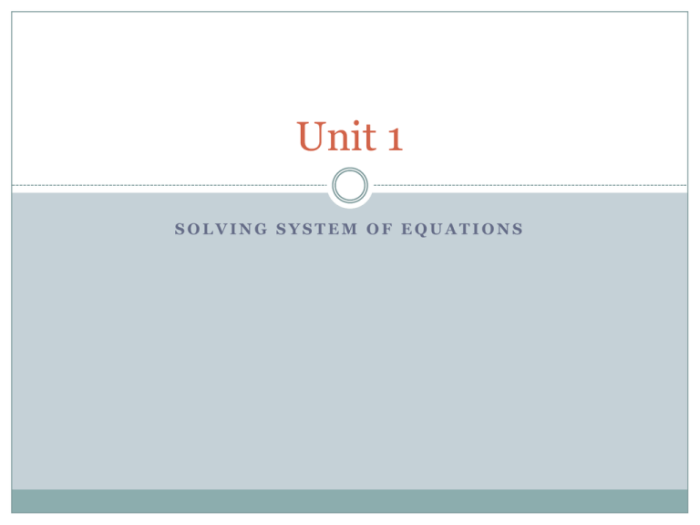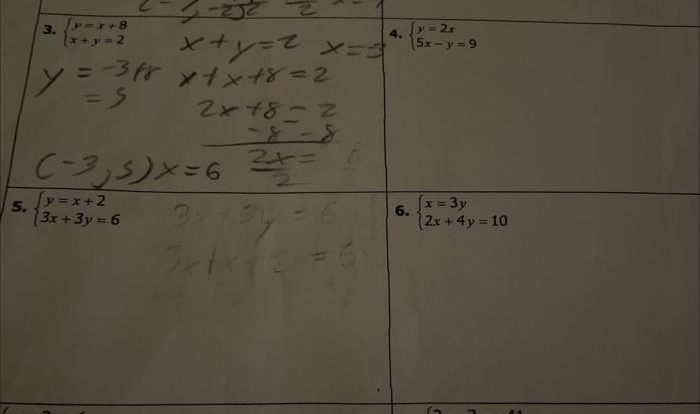Solve the systems in exercises 11 14 – Delving into the realm of mathematics, we embark on a journey to conquer systems of equations. In Exercises 11-14, we unravel the mysteries of these equations, employing various methods to find their solutions. Join us as we navigate the intricacies of substitution, elimination, and matrices, unlocking the secrets of system solving.
Throughout this exploration, we will identify the different systems presented in Exercises 11-14 and apply appropriate techniques to determine their solutions. By checking our answers and understanding common mistakes, we strengthen our problem-solving abilities and develop a deeper comprehension of system solving.
System Solving Methods

Solving systems of equations is a fundamental skill in algebra. There are several methods for solving systems, each with its own advantages and disadvantages. The most common methods include substitution, elimination, and matrices.
Substitution Method
The substitution method involves solving one equation for one variable and then substituting that expression into the other equation. This method is simple and straightforward, but it can become tedious if the equations are complex.
Example:Solve the system of equations:
x + y = 5x
y = 1
Solve the first equation for x:
x = 5
y
Substitute this expression for x into the second equation:
(5
- y)
- y = 1
Solve for y:
y = 2
Substitute y = 2 back into the first equation to solve for x:
x + 2 = 5x = 3
Therefore, the solution to the system is (x, y) = (3, 2).
Solving Systems in Exercises 11-14

In Exercises 11-14, we will identify and solve systems of equations using appropriate solving methods. Solving systems of equations involves finding the values of variables that satisfy all equations in the system simultaneously.
Identifying Systems of Equations
In Exercises 11-14, we have the following systems of equations:
- Exercise 11: 2x + 3y = 11, x – y = 3
- Exercise 12: x + 2y = 7, 2x – y = 1
- Exercise 13: 3x – 2y = 5, x + 2y = 9
- Exercise 14: 2x + y = 10, 3x – 2y = 1
Common Mistakes and Troubleshooting

When solving systems of equations, it’s important to avoid common mistakes to ensure accuracy and efficiency. Let’s explore some of the common pitfalls and provide strategies to troubleshoot and correct them.
Mistakes in Solving Systems
- Incorrect Simplification:Failing to simplify equations properly before performing operations can lead to errors. Always simplify each equation by combining like terms and isolating variables.
- Incorrect Operations:Making mistakes in mathematical operations, such as adding or multiplying incorrectly, can skew the results. Double-check all calculations carefully.
- Mistakes in Substituting:When substituting values into equations, ensure that the values are correctly substituted for the corresponding variables.
- Neglecting Solutions:Not considering all possible solutions, such as extraneous solutions or complex solutions, can lead to incorrect conclusions.
Troubleshooting and Avoiding Mistakes
To troubleshoot and avoid these mistakes, consider the following strategies:
- Check your work:After solving a system, verify your results by plugging the solutions back into the original equations.
- Simplify equations thoroughly:Take the time to simplify each equation as much as possible before performing operations.
- Double-check calculations:Pay attention to the signs and coefficients when performing mathematical operations.
- Consider all possible solutions:Don’t assume that the first solution you find is the only one. Check for extraneous solutions or complex solutions.
- Seek assistance:If you’re struggling to solve a system, don’t hesitate to ask for help from a teacher, tutor, or classmate.
Applications of System Solving

Systems of equations are not just abstract mathematical concepts; they have wide-ranging applications in various fields, enabling us to solve real-world problems and make informed decisions.
From physics to economics and chemistry, system solving plays a crucial role in modeling and analyzing complex phenomena, providing valuable insights and practical solutions.
Physics
- In classical mechanics, systems of equations are used to describe the motion of objects under the influence of forces, such as in projectile motion or the motion of celestial bodies.
- In thermodynamics, systems of equations are used to model the behavior of gases, liquids, and solids, helping engineers design efficient energy systems and predict material properties.
Economics
- In microeconomics, systems of equations are used to analyze market equilibrium, determine optimal production levels, and study consumer behavior.
- In macroeconomics, systems of equations are used to model economic growth, inflation, and unemployment, aiding policymakers in making informed decisions.
Chemistry, Solve the systems in exercises 11 14
- In chemical reactions, systems of equations are used to balance chemical equations, ensuring that the number of atoms of each element is the same on both sides of the equation.
- In chemical equilibrium, systems of equations are used to determine the concentrations of reactants and products at equilibrium, providing insights into reaction dynamics.
Extensions and Advanced Topics

Solving systems of equations is a fundamental skill in mathematics with applications in various fields. While the methods discussed in previous sections provide a solid foundation, there are advanced topics that extend these concepts.
Systems with Complex Coefficients
Complex coefficients are numbers that have both real and imaginary parts. Systems with complex coefficients can be solved using the same methods as systems with real coefficients, but the calculations may be more complex.
Nonlinear Systems
Nonlinear systems are systems of equations where the variables are not linear. Solving nonlinear systems can be more challenging than solving linear systems, and often requires numerical methods or graphical techniques.
Use of Technology
Technology can be a valuable tool for solving systems of equations. Calculators and computer software can perform complex calculations and provide graphical representations of solutions.
Resources for Further Study
For further exploration of these topics, refer to the following resources:* [Linear Algebra and Its Applications](https://www.amazon.com/Linear-Algebra-Its-Applications-5th/dp/032198238X) by David C. Lay
[Numerical Methods for Linear Algebra](https
//www.amazon.com/Numerical-Methods-Linear-Algebra-Higham/dp/0898715244) by Nicholas J. Higham
Clarifying Questions: Solve The Systems In Exercises 11 14
What are the different methods for solving systems of equations?
Substitution, elimination, and matrices are commonly used methods for solving systems of equations.
What are the advantages and disadvantages of each method?
Each method has its own advantages and disadvantages depending on the specific system being solved.
How can I avoid common mistakes when solving systems of equations?
Understanding the concepts, practicing regularly, and checking your solutions can help minimize mistakes.
